Menu
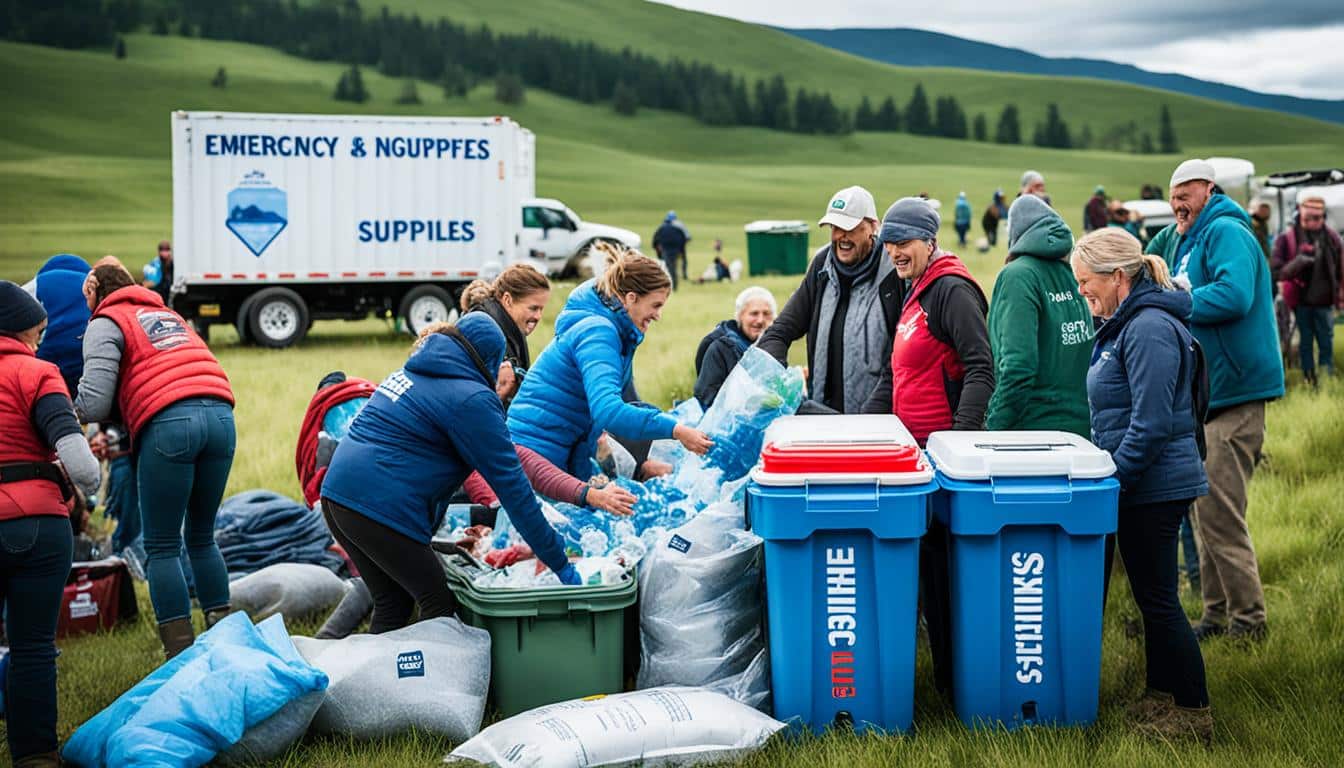
Rural areas in the United States can face tough challenges in preparing for emergencies. Small budgets and not enough staff are common issues in their hospitals and public health offices. Because they often lack local departments, they must wait longer for help from state agencies.
Rural regions deal with unique disaster hurdles like tornadoes and wildfires. Their remote locations and sparse populations make quick communication difficult. For better disaster planning, these places should involve their whole community. Everyone can help by doing what they’re good at, from local leaders to the emergency services.
Organisations such as the Institute for Rural Emergency Management (IREM) come in to give a hand. They provide helpful training and share the best methods for getting ready for disasters. Building strong bonds within the community and encouraging volunteering are key steps. This way, these remote areas can stand strong against their challenges.
It’s critical for rural communities to prepare for a wide range of disasters. Ready.gov advises tailoring plans to meet everyday needs. FEMA’s app can also provide important alerts and safety tips. These tools aim to keep rural areas as safe as possible when disaster strikes.
Emergency preparedness in rural areas is key to reducing big disaster impacts. It helps with a quicker recovery. It’s important to know that remote places have fewer resources for emergencies than cities. This means they face bigger challenges.
Rural places have tiny hospitals and health departments with few funds and staff. They struggle to handle emergencies well due to this lack. Big healthcare options might be far away. Plus, there may be communication problems during crises.
Rural communities often work with state authorities for health services. This can make their emergency response weaker. Coordinating help from different groups is hard but vital. The Institute for Rural Emergency Management (IREM) provides significant aid through training and other resources.
Volunteers are crucial for emergency help in rural areas. But, depending too much on them can lead to issues like not enough people for all shifts. Yet, close-knit communities often find ways to work around these problems. Setting up regular community meetings and emergency drills is essential.
Exercises to test response plans are key for figuring out what works and what doesn’t. They help different groups to work better together. Health workers who know the community well can help improve emergency responses. Improving how groups talk and support each other is essential.
Understanding rural people’s needs is vital when planning for disasters. Disaster plans need to connect with the community’s own plans to be effective. It’s important to push for specific disaster plans for rural areas. These should get support from lots of groups. And everyone in the community should help plan.
Rural communities face many challenges that make it hard to handle emergencies well. They often lack resources and struggle with getting good healthcare. Also, they are usually far from emergency services.
Rural areas don’t have as much money as urban places. This means they might not have enough equipment or people trained for emergencies. Lack of funds can slow down emergency plans, making the whole community less ready for a crisis.
Not having enough resources isn’t the only issue. Being far away makes things worse. It takes longer for help to arrive in these places. Plus, it’s tough to get everyone working together, from local to federal agencies. This can mean resources aren’t used as well as they could be.
Getting good healthcare in rural areas is tough. There aren’t enough doctors and nurses. Add to that things like not having clean water or enough healthcare services, and the situation gets more challenging.
People living far from hospitals deal with more health problems. They can’t always get care quickly. This affects how they deal with emergencies.
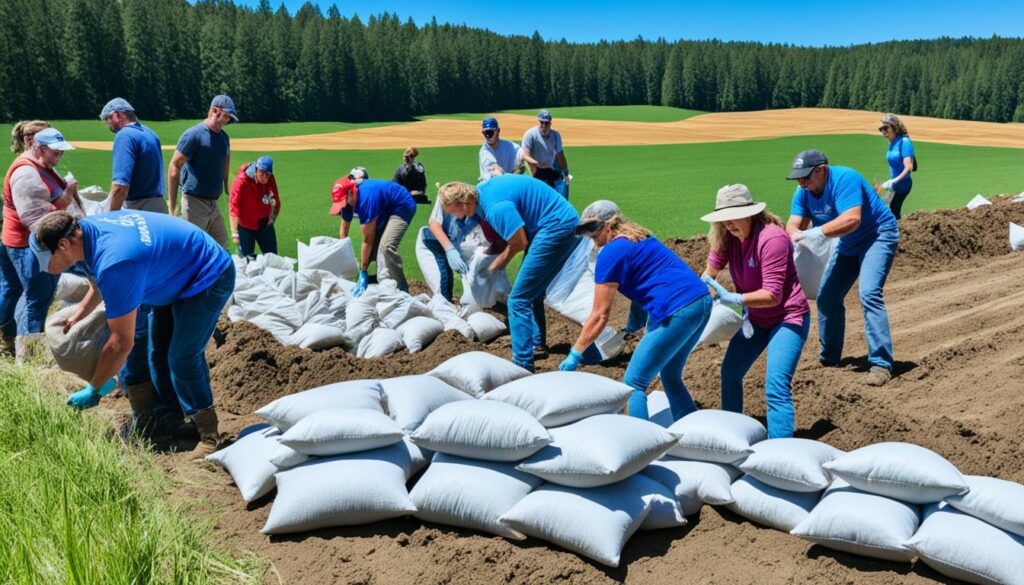
Also, rural places might not have good ways to communicate during crises. Poor internet and phone signals make it hard for first responders to work well. This makes handling emergencies even harder.
Lastly, rural areas often get left out when distributing important items in emergencies. Medicine, equipment, and other supplies might not reach them quickly. They might not have enough support when it’s needed most. Getting test results fast also becomes a challenge in these areas.
It’s clear that we need new and specific plans to help rural communities with emergencies. We must work on giving them more resources and better healthcare access. We should also improve how they can communicate in tough times.
For rural areas, everyone’s involvement in getting ready for emergencies is key. It starts with everyone, from the government to hospitals, working together. This makes sure the plan to respond to an emergency is strong and covers everything.
Local governments are vital in making sure people follow emergency rules. They make it possible for us to respond fast and well to disasters by teaching local groups what to do. They also help form teams of volunteers to help out after a disaster.
Hospitals and health teams are crucial for quick healthcare in emergencies. They train to make sure care continues even when it’s chaotic. This includes learning to work well with all parts of the community, from churches to veteran groups.
Having a clear plan for volunteers makes help come more smoothly. By always learning and getting better, we make sure we’re ready to face any disaster. This shows how working together in our communities is what really helps us recover from tough times.
A whole community approach brings together the many resources, skills, and knowledge found in rural areas. It focuses on making communities stronger during emergencies. This includes the help of local people and groups to boost readiness.
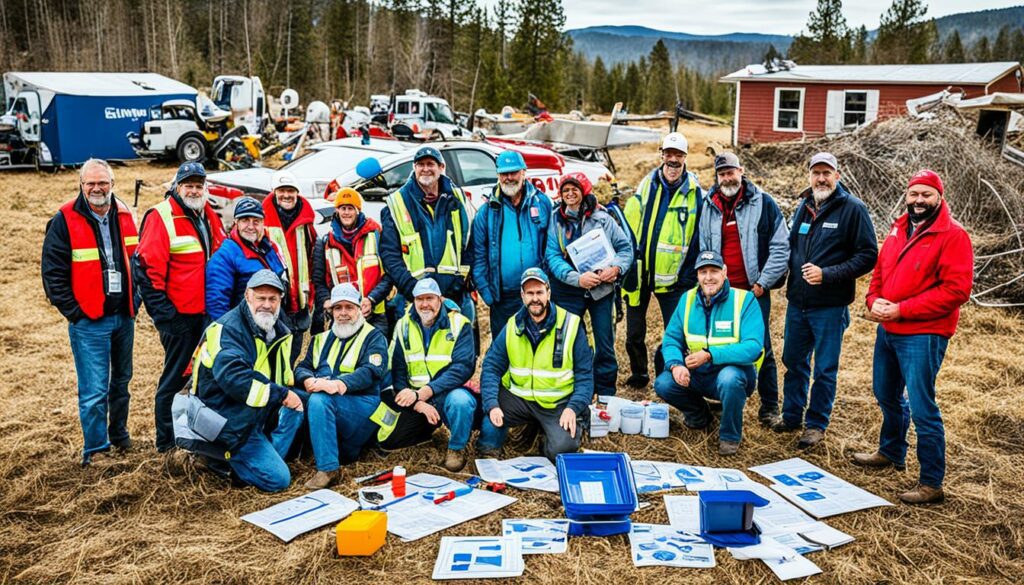
Rural areas often lack the resources needed for emergencies. Local health departments, for example, work with small teams and budgets. Bringing various partners together, as suggested by FEMA, helps. It lets communities look closely at their risks and strengths.
It’s key to build strong links between community members and organisations. This helps tackle problems in emergency planning. Even with little money and changing staff, good communication and joint effort are vital. FEMA promotes the use of 32 Core Capabilities to identify and lessen risks.
For good emergency plans, using the right data is essential. Surveys like CHNAs and CHAs and tools like CASPER help understand community needs. They work out who’s at risk and what resources are available. Tools like COIN and SVI pinpoint who may need help during a crisis.
Training, like tabletop exercises, is very important. These practice runs prepare both organisations and the public for emergencies. They also help create a readiness culture in a community. This means offering regular training and chances to practice can make a big difference in how well a community handles disasters.
| Challenges | Strategies | Supporting Agencies |
|---|---|---|
| Resource Limitations | Multi-stakeholder Collaboration | FEMA, CDC |
| Healthcare Access | Needs Assessments | Local Public Health Departments |
| Longer Response Times | Strong Community Relationships | EMS, Local Governments |
Dedicated groups play a key role in rural emergencies. They focus on getting ready and reacting fast. For rural areas, local health departments and EMS are vital for staying strong.
In rural emergencies, local health departments lead the way. But, some places don’t have them. They have to look to state agencies for help, which slows things down. With little money and few resources, they struggle to help everyone who needs it.
Rural EMS is fundamental for quick medical help. It can make a big difference in saving lives. Yet, these services deal with many challenges. Lack of funds, big areas to cover, and poor roads are common issues.
To beat these hurdles, communities can work together. They can form strong bonds and volunteer when needed. This teamwork is vital during emergencies, helping where formal services fall short.
Across local, state, and national levels, groups team up. The Institute for Rural Emergency Management (IREM) also lends a hand. They all make rural readiness better. With custom plans and lots of community action, dealing with emergencies gets easier.
Resource management in rural areas is crucial for handling emergencies well. These places often lack enough resources. They also have less money and fewer health departments. This makes them more at risk during emergencies. It’s important to spread out resources well to deal with emergencies effectively.
Rural hospitals often struggle with money issues, affecting their emergency responses. They also have to cover larger areas, which means it takes longer to reach people. Problems with communication and warning systems add to this. Working together is key for rural areas to prepare for emergencies better.
There are several important steps to handle resources better in rural areas:

Studies show that spending $1 on preparation can save $6 on response and rebuilding. This shows how critical it is to prep for emergencies in rural areas.
This table compares rural challenges with their solutions:
| Challenges | Solutions |
|---|---|
| Resource Limitations: Equipment, Supplies, Training | Enhanced Coordination and Funding for Training Programmes |
| Financial Constraints of Rural Hospitals | Increased Government Support and Financial Assistance |
| Longer Response Times | Developing Localised Response Units |
| Communication and Infrastructure Issues | Investing in Advanced Communication Systems |
I strongly believe that by using resources well, we can make rural areas better prepared for emergencies. This is vital for their safety and future resilience.
Good communication saves lives during emergencies in rural areas. With disasters often sudden and overwhelming, clear communication is key. Develop strong, specific plans to face the unique needs of rural places.
Rural areas face challenges like being far apart and not having much technology. This slows the spread of important messages. Also, limited money and resources make it harder for health and hospital teams to communicate well during crises.
But, there are ways to make rural communication better in emergencies. Building strong links within the community and encouraging volunteer work helps spread important information. It’s essential to work with local health groups, the police, and emergency services to ensure everyone gets the help they need.
Regular tests by states and FEMA check if alert systems work properly. They are done monthly and every three years, respectively. It’s important to use many communication methods like alerts, websites, and social media to get important information to as many people as possible.
Places far from cities should have good crisis communication plans in place. This means making sure messages are clear and can be understood by everyone. Offering translations, various ways to get messages, and testing them in advance are critical. In an emergency, information is just as vital as food and water.
How people react to alerts depends on many things, like age and family situation. Knowing this helps to tailor messages for better impact. By making alerts more specific and timely, they can have a greater effect.
The aim of preparing for emergencies in rural areas is to keep everyone safe and informed. This includes working to prevent harm, educating people, and helping where needed. By focusing on communication, rural places can be better prepared for any emergency.
Natural disaster prep in rural places needs careful thought. Tornadoes, floods, and wildfires are common threats. They quickly use up local resources. So, rural communities must plan well to reduce these impacts.
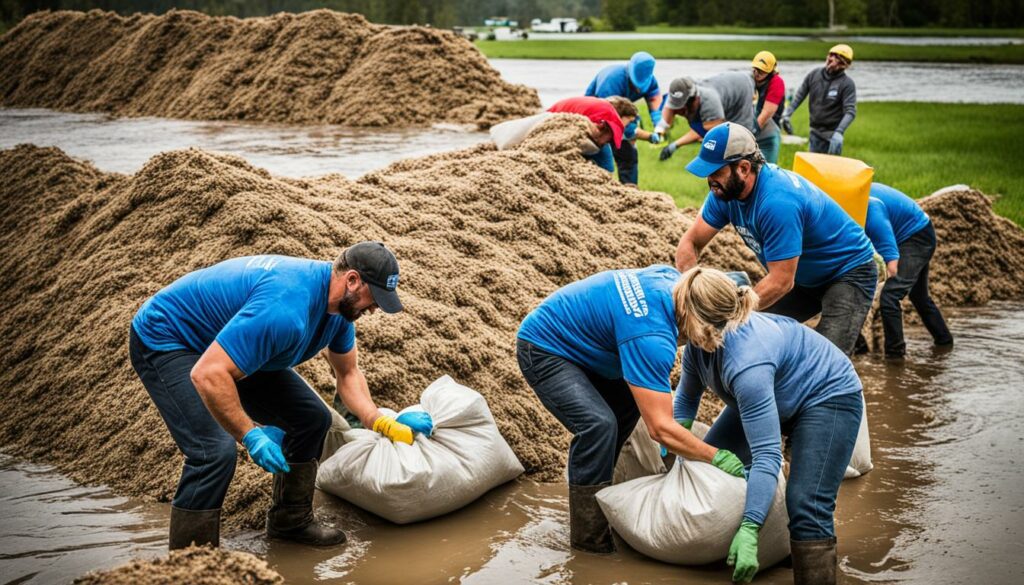
Rural areas in the Midwest often face tornadoes. These big storms can destroy whole towns. So, it’s key to teach people how to stay safe. Knowing where the safest places are and spotting tornado signs early are vital.
Regular safety drills and good communication are important. They make sure everyone knows what to do.
Floods hit rural areas hard. It’s tough to evacuate when there are not many people around. Plus, they are far from help. To be ready, communities must figure out where floods happen most. They should also warn people early and plan escape routes.
Having set meeting points helps keep things orderly in an emergency. It’s all about being organised.
In dry places, wildfires are a big worry for rural folks. Fighting these fires over large areas is hard. So, communities should work together before fires start. This means clearing dead plants, making barriers, and getting firefighting gear. Setting up fire safety lessons for everyone helps lower the fire risk.
In the end, rural areas facing disasters need specific plans. Preparing ahead and working together can really help. This makes communities stronger against tornadoes, floods, and wildfires.
Knowing rural challenges in disasters, like less resources and being far from help, helps us get ready better. Everyone playing a part in safety and emergency plans is key. This way, rural people can protect lives and homes better.
Law enforcement and fire departments are crucial in rural areas for disaster response. They offer the first help when disaster strikes. Their job is to keep order during the chaos of emergencies. Yet, they face unique challenges in the countryside.
In rural areas, they often lack resources like modern tools and enough training. This makes their response to emergencies harder. With poorly developed systems, they find it tough to act quickly and efficiently.
Rural hospitals and health units also struggle due to less local funding. They depend more on state aid, affecting their emergency response abilities. This issue underlines the need for better planning to overcome rural challenges.
Rural areas have many older, disabled, and poor people. They need special help during disasters. With sparse population and wide areas, it takes longer for help to arrive. This makes the jobs of responders even harder.
In rural places, EMS services often rely on unpaid helpers without health insurance. This affects their health and benefits. These caring helpers need more support for their work to continue.
Planning for all types of emergencies is key. It includes things like getting the right gear, stopping infections, and planning for when supply chains break. Disaster response planning must cover all bases.
During crises like COVID-19, emergency workers face tough times. They work more and face new dangers. The U.S. Department of Homeland Security and SAMHSA help them look after their mental health. They provide needed support and training.
Good disaster response planning in the countryside depends on teamwork. Law enforcement, fire crews, and support units must work together. Efficient use of resources and being ready to adapt boost their community’s safety.
Learning how to respond to emergencies is crucial in rural areas. It makes communities stronger and ready to act in crisis. I will discuss how training and drills make this possible.
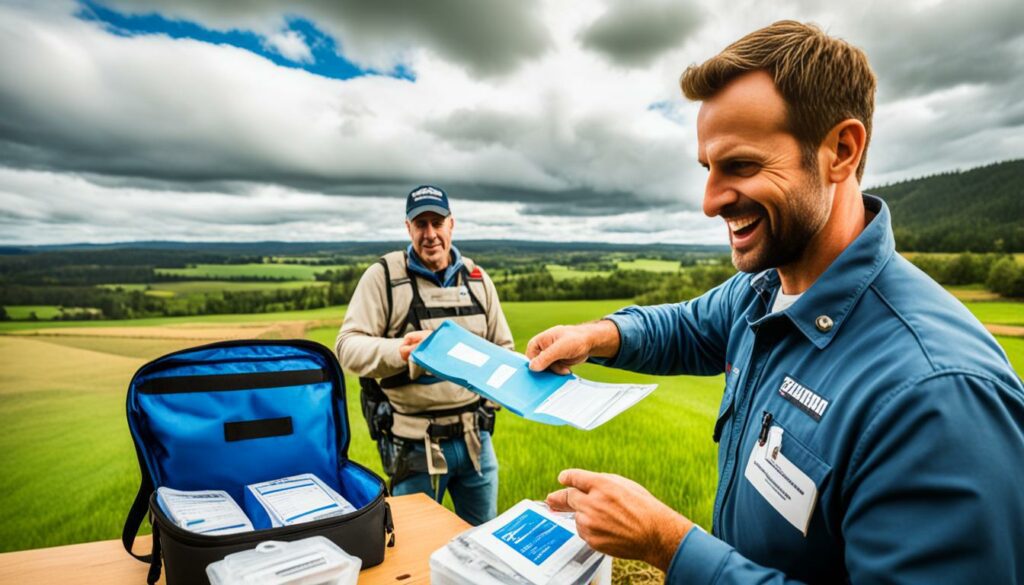
Specific training programmes teach rural people vital skills for emergencies. They cover various situations, such as floods, wildfires, and pandemics. These programmes are designed to support local resources and address any shortages found in studies.
Taking part in these trainings helps residents understand how to work with others during emergencies. This skill is important in rural areas without many local health services. They must work with state groups, which have limited money and staff, for help.
Training covers all types of emergencies, not just one. It teaches people to manage any crisis effectively. There are also lessons on stopping infections to prepare for diseases like pandemics.
Drills are key in training. They let people practice what they’ve learned in a controlled way. Drills are needed to find and fix problems in the emergency plans. Everyone learns what they need to do.
In rural places, everyone works together during drills. This teamwork strengthens their emergency skills. It helps overcome the challenges rural communities face, like little resources.
All this training and practice helps rural areas stand strong during disasters. It shows how important it is for everyone to work together to be ready for anything.
Effective emergency planning in rural areas needs careful thought. It’s about preparing so that a community can stay strong when disasters hit. This means using what you’ve got, learning together, and working closely. These steps help communities to be ready and respond well when bad things happen.
Rural areas face big challenges because they often have fewer resources. This lack can slow down how well a community prepares for emergencies. Also, long waits for help can happen because the areas are big. They might not have good ways to talk to each other or warn everyone when needed. All this can make dealing with disasters harder.
In rural places, health and emergency teams might not have as much money or as many people as they need. This shortage can make it tough to give quick help during emergencies. Moreover, there may not be enough volunteers to help everyone when it’s really needed.
The National Incident Management System (NIMS) helps make sure everyone works well together in emergencies. It’s especially useful in rural places. Planning for all kinds of dangers helps make sure the right resources are ready for any emergency.
Planning for a disease outbreak in the countryside means getting gear for those first on the scene. Also, finding folks who can help and teaching the community basic health tips can lessen the need for emergency services. Some people might need more help than others, like the elderly or those with certain conditions. Not having enough ways to warn people can also make it harder to get ready for a disaster. It’s key for many groups to work as one to fix these issues.
Rural areas are far from others and can be tough to get around in if you’re not well. It’s important to not lose touch with loved ones in tough times. Have a solid emergency plan, with ways to warn each other, places to go for safety, how to leave if you have to, and how to stay in touch with family. Don’t forget about special medical or food needs when planning.
During a power cut, having ways to keep medical gear and phones working is vital. Devices that can alert others if you’re in trouble make things safer. Prepare emergency kits for your home, job, and car. Make sure they have what you need and update them regularly to be ready.
Being ready financially also matters. Have your money sent straight to your bank so it’s there when you need it. The Direct Express® card can make getting benefits safe and easy, even in a crisis.
It’s key to have a personal emergency plan, especially if you live in the countryside. Rural areas have their own set of challenges like limited services and being far from hospitals. Your plan should cover all kinds of emergencies to keep you safe and ready.
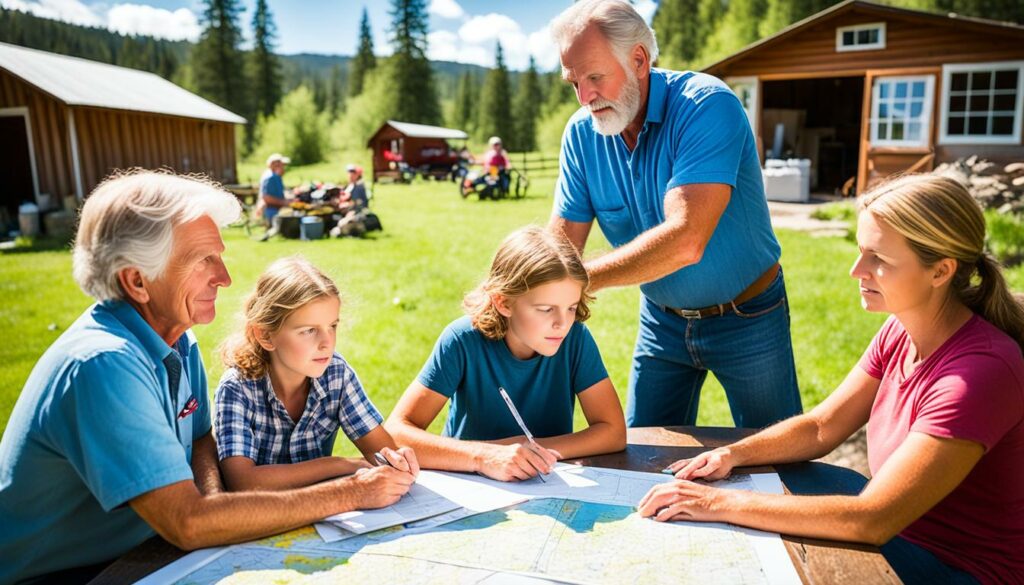
Make a disaster preparedness kit that has everything you need. Include items like food that won’t spoil, water, a torch, batteries, and a first aid kit. Don’t forget personal things like your medicine, important papers, and a list of contacts. Having a complete kit makes you ready to handle any emergency.
| Item | Purpose |
|---|---|
| Non-perishable food | Ensures sustenance during prolonged emergencies |
| Water | Essential for hydration and hygiene |
| Flashlight and batteries | Provides light during power outages |
| First aid kit | Basic medical supplies for injuries |
| Prescription medications | Continued care for existing medical conditions |
| Important documents | Identification, financial, and medical records |
| Emergency contact information | Facilitates communication with family and responders |
For medical emergencies, plan ahead to meet your family’s needs. Always have enough medicine and know where the closest hospital is. Think about how you’ll get medical help in a crisis. Planning carefully is even more important in rural areas where healthcare is not as easy to reach.
The Institute for Rural Emergency Management (IREM) advises working with local emergency teams for a personalised medical plan. This teamwork with community health services helps you handle medical crises better, making you and your family safer and more ready.
The all-hazards approach to emergency planning is key for rural areas. It helps them get ready for many types of crises. Not just for getting resources and working together. But also for understanding the risks and how these places might be more vulnerable.
Risk assessment, or hazard vulnerability analysis, is vital for rural areas. It helps them spot the dangers they often face. By doing this, they can focus their plans on what’s most likely to happen and where they need to put their efforts. This is crucial due to their challenges. These include tight budgets, long response times, and sometimes not the best infrastructure. A thorough risk assessment sets a solid base for being ready for anything.
The CDC set national standards to boost how ready we are for emergencies. It also crafted tools like CASPER and the SVI. These tools quickly spot which communities need more help when disaster strikes. They are a big help for rural places that rely more on state help.
It’s vital to have hands-on training and drills that match the all-hazards plan. By involving everyone from hospitals to the police, and by following FEMA’s and HHS’s advice, plans become more real and doable. This way, rural areas can buff up their emergency game.
Emergency preparedness is about planning for and dealing with emergencies. For rural areas, this means creating plans to handle and bounce back from disasters. It’s about managing resources, getting the community involved, and planning for different types of disasters.
Rural areas prep for emergencies in several ways. They make emergency plans and hold meetings to keep everyone in the loop. They also practice with emergency drills and make sure their gear is ready. Each person has a role in the plan, and they work closely with local groups like the police and hospitals.
Rural places can find it hard to prepare for emergencies. They often lack the resources and training they need. The area’s size and the few healthcare options can also be big problems. Overcoming these issues requires coming up with smart plans and working together as a team.
Getting everyone in the community involved is key in rural areas. It means making sure everyone does their part and uses what they know to help. The government and health services must also be part of the emergency plans to make sure everything runs smoothly.
In a whole community approach, everyone helps. It’s about using what each person knows and can do to prepare for emergencies. This way, when something bad happens, the whole community can come together and respond.
Groups that focus on emergencies, like the local health department or EMS, are very important in the countryside. They face challenges but are essential for getting ready and dealing with disasters.
Using what little they have wisely is crucial in rural areas. Knowing what’s needed most and sharing resources well helps manage emergencies. It makes the disaster response smoother and more efficient.
Communications can be tough in the countryside, but it’s crucial during emergencies. Being ready with different communication ways and plans helps keep everyone informed, even in isolated spots.
They get ready for disasters that are common for their area. This might mean spreading information, planning how to evacuate, and taking steps to reduce the risk of a disaster happening.
These teams are very important right after a disaster. They help keep things under control and make sure everyone is safe. The first steps they take are crucial for the overall response.
By practicing and learning, people in rural areas get better at dealing with disasters. Training and drills help make the community stronger and more able to face challenges.
To make a personal emergency plan in a rural area, start with a kit and think about healthcare needs. Adapt these plans for what you might need personally. This helps keep you safe, even in far-off parts.
This way of planning means being ready for all sorts of emergencies. It looks at what could go wrong and makes sure everyone is ready to face whatever comes their way.